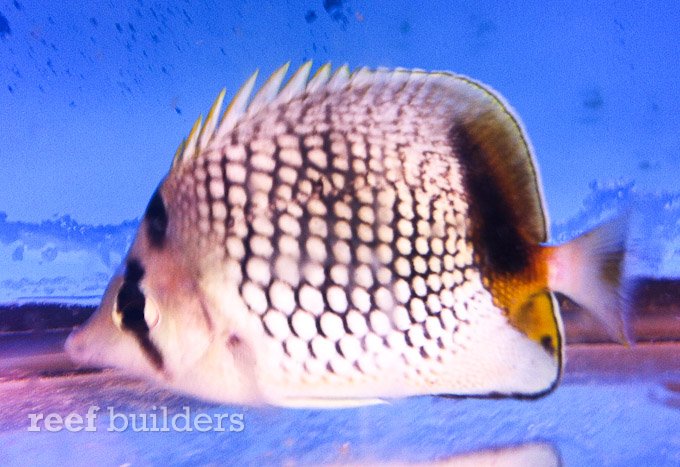Hybrids in the butterflyfish realm are few and far between, but if there ever were to be a gang of promiscuous species, it would definitely be the members of the pearlscale butterflyfishes, otherwise known as the Xanthurus complex. The Xanthurus complex boasts of similar looking popular aquarium species such as Chaetodon xanthurus, C. mertensii, C. paucifasciatus and C. argentatus.

Of the few, C. xanthurus and C. argentatus are known to readily form hybrids with other species, or in this case above, amongst themselves. The stunning hybrid butterflyfish above is a great example of a cross between Chaetodon argentatus and C. xanthurus imported from Cebu by Aqua Terra Distributors.

The common pearlscale butterflyfish and the argentatus butterflyfish are the most prolific members within this group. C. xanthurus is a common widespread Indo-pacific species that occasionally hybridizes with other species, like C. guentheri. We stumbled upon a dying specimen of this hybrid last year, and what a shame. On the other hand, C. argentatus is a lesser seen member compared to its more common cousins.
While it cannot be considered rare in the wild, C. argentatus is not common and only enters the trade sporadically. It stands out from the complex due to the absence of the characteristic orange-red coloration on the back. Instead, this species is predominantly black and silver. The argentatus butterflyfish has been documented to hybridize with the wrought iron butterflyfish in the wild.

The particularly interesting hybrid we feature at the very top of this article and immediately above is from a cross between the two aforementioned species. As expected, the mixing of the two species results in the “dirtying” of the orange back in C. xanthurus due to the genetic input of C. argentatus.
The orangey-black back trait for this hybrid is different and unique to each individual, much like a thumb print. This applies to most other hybrid fish as well. As genetic information from each parent is unevenly distributed and exchanged, the possibilities in color that would result is nearly infinite. Not to mention that parents could also be hybrids themselves.

Most specimens of such hybrids will show a fulvous orange, almost yellow back with varying amounts of black, unlike the highlighter orange in pure blooded C. xanthurus. The input of black coloration in the back is interesting in a sense that it can either manifest itself as a distinct black entity within the orange, or a black smudge, or in rare cases, totally black back with hardly any orange.
Another beautifully interesting trait that these hybrids show is the intensification of the cross hatch patterns. Both parents show similar crosshatched markings but when crossed, the resulting hybrid bears resemblance to a Wrought Iron Butterflyfish with an inverted color scheme! The Argentatus x Xanthurus hybrid is quite commonly found in the waters of Japan but are only very rarely caught and encountered in the Philippines.



